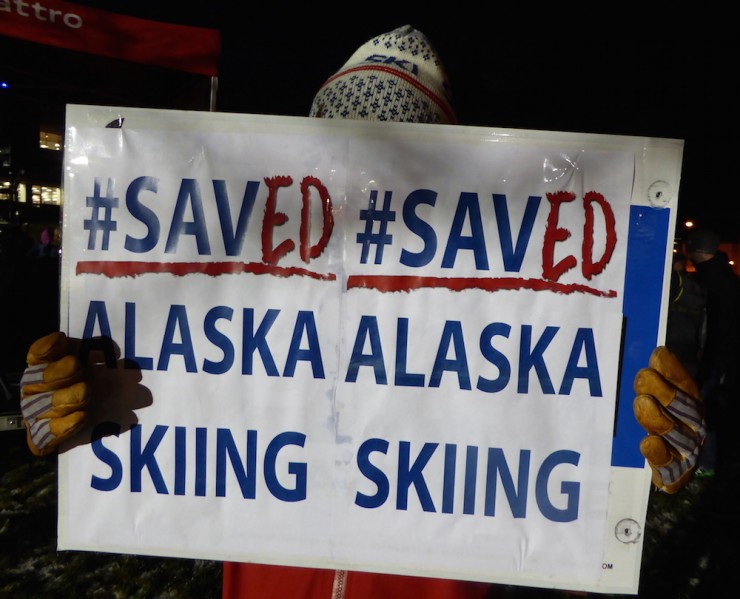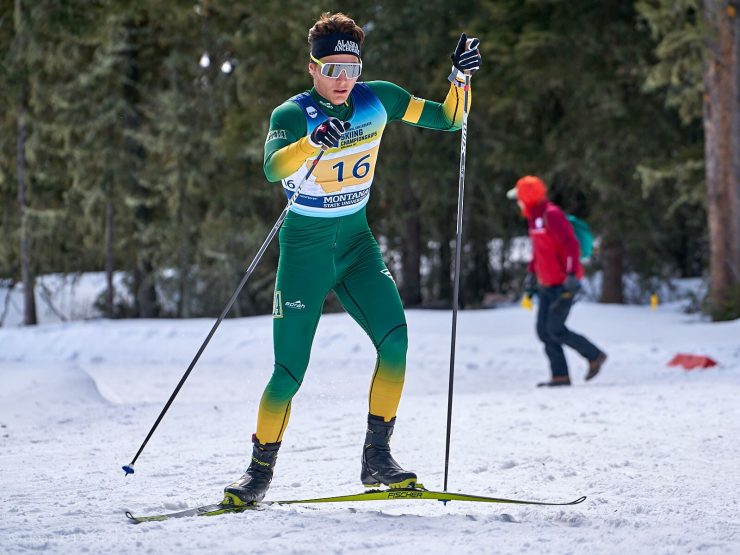
ANCHORAGE — For the second time in four years, nordic skiing has been saved at the University of Alaska Anchorage, following a serious proposal to eliminate the ski team entirely. This time around, the victory is somewhat more of a pyrrhic one, as the University of Alaska Board of Regents voted Thursday to eliminate the alpine portion of the men’s and women’s ski team, unless supporters can raise over a half million dollars in advance funding over the next few months from private sources.
The math is stark, and has multiple implications for supporters of collegiate skiing at one of Alaska’s two NCAA ski programs. (Alaska Pacific University does not have NCAA affiliation.) On the one hand, as far as the NCAA is concerned, a college ski team without an alpine team is just as much of a team as one with alpine athletes – two teams, in fact, “men’s skiing” and “women’s skiing.” Cutting alpine skiing therefore lets UAA continue counting skiing as two sports, at effectively half the price tag as before. When it comes to the 10-team minimum for NCAA Division II status, a college ski team with only nordic athletes is still a team in the eyes of the NCAA.
On the other hand, a college ski team with no alpine skiers is by definition not going to be very competitive at the NCAA Championships level. Team scores for skiing are based on total points scored by nordic and alpine skiers combined. Schools such as University of Alaska Fairbanks and Northern Michigan University show that it is possible to have a rich standalone nordic tradition; current American World Cup-level skiers who attended those schools include Tyler Kornfield, Logan Hanneman, Ian Torchia, and Rosie Frankowski. But those schools placed 16th and 12th at the 2020 NCAA Championships, and 15th and 7th in 2019, since they could only potentially score half as many points as a school that also fielded a full alpine team.
When this news was first announced last month, UAA Chancellor Cathy Sandeen was recommending the complete elimination of both men’s and women’s skiing, as well as men’s hockey and women’s gymnastics. By the time of today’s Board of Regents meeting, Sandeen instead presented an alternative plan that would cut only alpine skiing after the current season, as well as hockey and gymnastics.
The Anchorage Daily News quoted Sandeen as telling the board at today’s meeting, “We understand we are becoming a focal point for cross-country skiing (nationwide). We are part of that growing movement of cross-country skiing in Anchorage.”
The ADN also provided more details of Sandeen’s proposal, which was adopted by the board: The other three sports have from now till February 2021 to raise enough money through private donations to cover two years’ worth of operating expenses. If alpine skiing can come up with $628,000, gymnastics with $880,000, or hockey with $3 million, the Board of Regents will consider keeping each sport beyond the 2020/2021 school year.

FasterSkier reached out to Head Ski Coach Sparky Anderson for comment. (UAA does not currently have a head nordic ski coach or an assistant nordic ski coach, though it is working through the hiring process to fill this position.)
In a Thursday email to FasterSkier, Anderson provided some perspective on this nordic/alpine solution, writing, “The NCAA defines skiing only in terms of gender. We are required to have five athletes in either gender to field a team. The makeup of that team by discipline is up to each program. We all know that to win an overall title, which we have been close to doing in the past, requires men and women on nordic and alpine skis. I hope to educate our administration that the best path forward is to only travel with our top scoring athletes of either discipline and fundraise for the opportunity to travel and train a larger group. We have all the infrastructure in place to be able to do just that.”
Anderson continued, “Today’s decision demonstrates the understanding that NCAA skiing is important to our community. I am grateful to the regents and to our chancellor for understanding that. My goal moving forward is to help our administrators understand the nuance of our sport, the fact that we can use the numbers we are given to have at a minimum what we need, and fundraise for what we want. Because what everyone on this UAA Ski Team wants is to hoist a big NCAA trophy in March, and that doesn’t happen unless we stick together as one team. I see a pathway forward where this is possible and I’m going to do everything in my power to make that happen.”
As laid out in magisterial detail last week on volunteer assistant coach Adam Verrier’s blog, cutting men’s hockey leaves UAA with only one men’s team sport, men’s basketball. (Notwithstanding the heavily team-centric nature of NCAA skiing competition, any sport that crowns individual champions – skiing, wrestling, etc. – is not classified as a team sport under NCAA bylaws.) Verrier explained a theory under which supporters of UAA skiing could seek a bylaw amendment to allow Alaska to count skiing as a team sport for NCAA purposes. At no point did Verrier, or anyone else associated with the ski team, advocate for cutting alpine skiing in the process.
Gavin Kentch
Gavin Kentch wrote for FasterSkier from 2016–2022. He has a cat named Marit.



